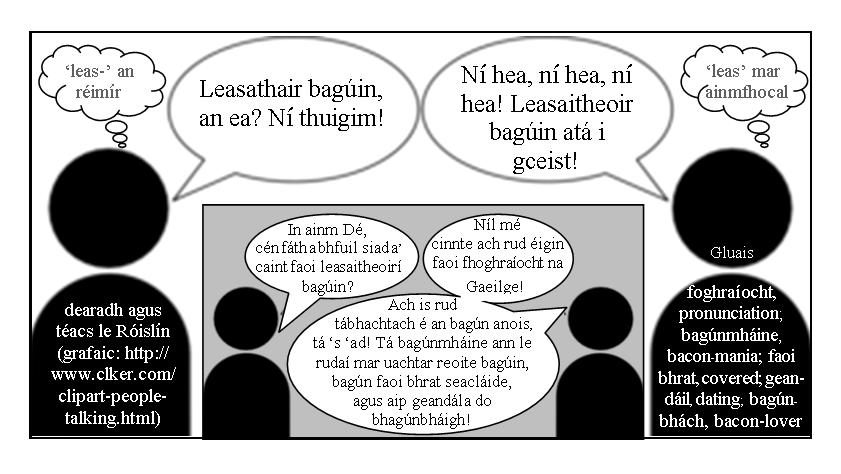How to Pronounce Irish Words with the ‘Leas-‘ Prefix (Cuid/Part 2) Posted by róislín on Nov 22, 2016 in Irish Language
(le Róislín)
In the blogpost for November 12, 2016 (nasc thíos), we looked at various words with the prefix “leas-,” going beyond the typical meaning of “step-” (as in leasdeirfiúr and leasdeartháir). We got through about half the planned examples, like “leas-” before vowels, as in “leasainm” (nickname) and “leas-” before the consonants “c” and “m” (leaschodán, improper fraction — how judgmental sounding! — and leasmháthair, stepmother). In today’s blogpost, we’ll look at the remaining three categories:
d)) “leas-“before leniteable consonants that don’t lenite after “leas-“(Yeah, sounds strange and triggered a foláireamh athluaiteachais in the Part 1 blogpost — but that really does describe the situation),
e)) “leas-” before non-leniteable consonants (like “r,” no changes so …. easy peasy, or in Irish, “éasca péasca“)
f)) “leas-” occasionally changing to “leis-,” at least in earlier forms of Irish.
And we still need to look at the subtle distinction in pronunciation between pairs of words like “leasathair” and “leasaitheoir,” which have, needless to say, completely different meanings.
Starting with point d:
d)) What happens to an inital “d” or “t” or “s” after the prefix “leas-“? Short answer: tada nó faic nó chun beocht a chur air, ní tharlaíonn faic ná fríde. In other words, nothing! So, no change to words like the following: deirfiúr, deartháir, seanmháthair, seanathair, seansáiléir.
leasdeirfiúr [LyASS-DJERzh-uh-fyoor], stepsister; remember the slight vowel sound between the “r” and “f” of “deirfiúr” that is not indicated in the spelling.
leasdeartháir [LyASS-DJAR-haw-irzh], stepbrother
leas-seanmháthair [LyASS-SHAN-WAW-hirzh or … VAW-hirzh], stepgrandmother. Note: the fleiscín is because of the double consonants)
leas-seanathair [LyASS-SHAN-AH-hirzh], stepgrandfather, with the fleiscín as noted above.
leas-seansáiléir [LyASS-SHAN-SAWL-yayrzh], vice-chancellor
If there were a real word starting with “leas-” for “step-” and then with the next part starting with “t,” I’d use it here with the samples but I can’t think of a single realistic example. However, we see a similar process in words like “seanteach,” “an-sásta,” and “An Sean-Tiomna,” where the “n” of “sean” or “an-” also blocks the lenition of “t” or “s.” There’s even “leasteangeolaíocht” (showing no change to the “t” after “s”), but that’s from “leas,” the noun, meaning “benefit,” “advantage,” “curing” (as in bacon — remember the “leasaitheoir bagúin“?), not to mention “manure.” OK, so I mentioned it anyway — all in the time-honored tradition of “parathagra” (.i. paralepsis aka apophasis and antiphrasis). Someday, the noun “leas” will have it’s own blogpost here — 10 ways to say “manure/dung” in Irish. Anyway, what does “leasteangeolaíocht” mean? Féach an nóta thíos.
Normally, of course, these consonants (d, t, s) can be lenited , as in “domplagán Dhónail,” “tomhas Thomáis,” and “seomra Sheoirse.” It’s only because “leas-” ends in “s” that we have the above exceptions. It’s part of the DNTLS rule.
e)) “leas-“before non-leniteable consonants (like “r)
leasrí [lyass-ree], viceroy, regent
leasrúnaí [LyASS-ROON-ee], deputy secretary
A few more we haven’t previously mentioned ion this series:
leasleabharlannaí [LyASS -LyOWR-lahn-ee], deputy librarian
Leas-PhríomhLeabharlannaí [LyASS -FRzhEEV-LyOWR-lahn-ee], Deputy Chief Librarian
leas-phríomhfheidhmeannach [LyASS -FRzhEEV-AIM-yan-ukh], deputy chief executive; note: the “aim” in the transcription is like “rhyme” or “time” or “I’m”, and the following: ph = f, mh = v, fh is silent, and the final “ch” is like German “Buch” and Welsh “bach.”
leas-phríomhoifigeach feidhmiúcháin [LyASS -FRzhEEV-IF-ig-yukh FAIM-yookh-aw-in], deputy chief executive officer
Leas-Phríomhchigire [LyASS -FRzhEEV-HyIG-irzh-uh], Deputy Chief Inspector
And finally, for section “f,” here’s one example with the more traditional prefix, “leis-“, before a word that begins with a slender consonant, in this case, “cliamhain“:
f)) leis-chliamhain [LESH-HLyEE-uh-win], a stepson-in-law
If we went back far enough in time, this “leis-” would probably have applied across the board to words beginning with slender consonants, but that would take us fully back into older spellings, like “dearbhráthair” or “inghean.” As it is, “leis-chliamhain” is the only well-known example I’ve seen of this sort that hasn’t been updated in spelling. So it’s good to know about, but probably one you don’t really have to use particularly often.
And finally, I mentioned comparing “leasathair” with “leasaitheoir,” just “le haghaidh an chraic.” “Leasathair,” of course, consists of “leas-” + “athair.” “Leasaitheoir,” on the other hand, is based on the noun “leas,” which means “curing” in addition to its wide array of other meanings, including “benefit,” “advantage,” and “manure.” The ending “-eoir” is quite common in occupational terms or in names of devices and appliances: múinteoir, cuisneoir, aisteoir, srl. The following transcription shows the difference:
leasathair [LyASS-AH-hirzh], stepfather (the first two syllables are both stressed, as shown by the caps)
leasaitheoir [LyASS-ih-hyorzh], curer (as in leasaitheoir bagúin, bacon curer), only the first syllable is stessed, as shown by the caps. .
We’ve got one more blogpost in this series, for “stepson” and “stepdaughter,” and that will be the last of the “leas-anna,” at least for a while. Even I’m eager to move on to a few other topics, especially since I’ve got a backlog of around 50 already roughly laid out! HTHed agus SGF — Róislín
Nasc: How to Pronounce Irish Words with the ‘Leas-‘ Prefix (Cuid/Part 1) Posted by róislín on Nov 12, 2016 in Irish Language
Nóta (gluais): cigire, inspector; codán, fraction; leasteangeolaíocht, remedial linguistics; le haghaidh, for, for the sake of; parathagra, apophasis (lit. para-, para- + tagra, pleading, discussion) — I have to admit this word looks more like a type of Indian yoga than a rhetoric term in Irish, but that’s the case. You say you’re not going to mention something and then you go ahead and mention it!

Build vocabulary, practice pronunciation, and more with Transparent Language Online. Available anytime, anywhere, on any device.





Leave a comment: